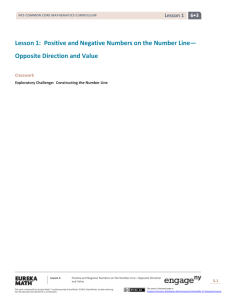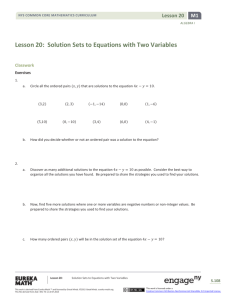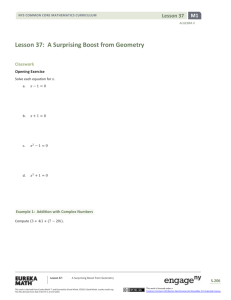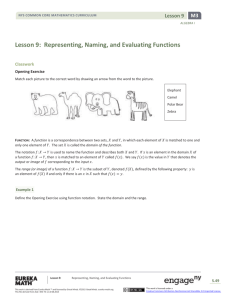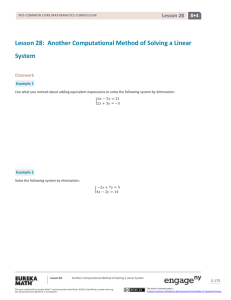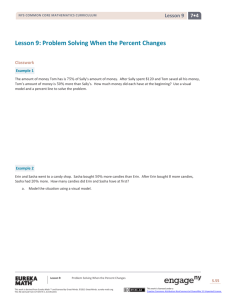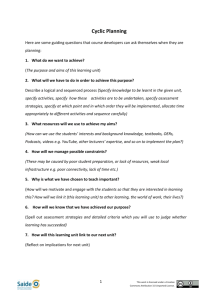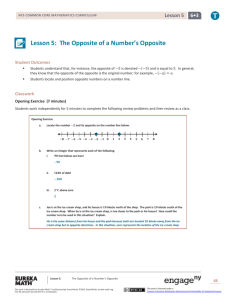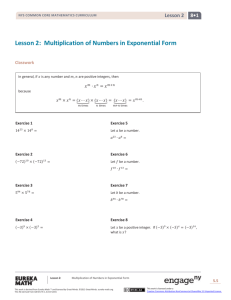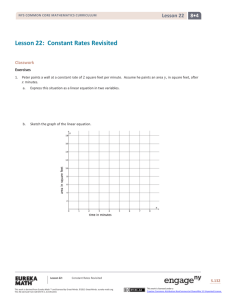Algebra II Module 3, Topic E, Lesson 33: Teacher Version
advertisement
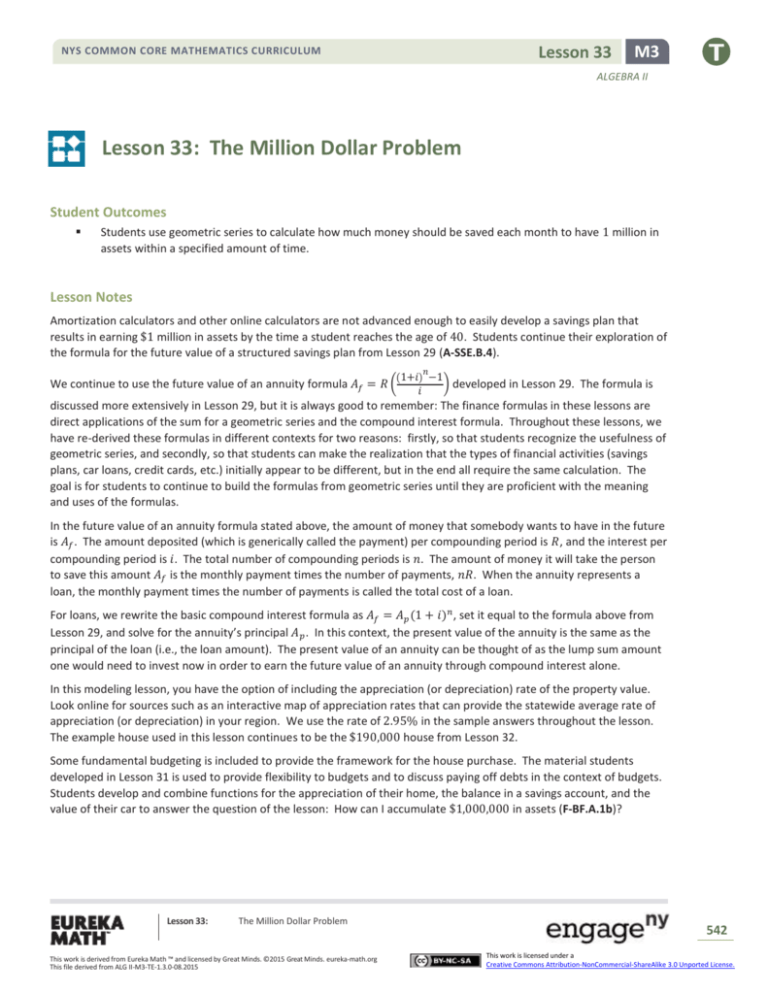
Lesson 33 NYS COMMON CORE MATHEMATICS CURRICULUM M3 ALGEBRA II Lesson 33: The Million Dollar Problem Student Outcomes Students use geometric series to calculate how much money should be saved each month to have 1 million in assets within a specified amount of time. Lesson Notes Amortization calculators and other online calculators are not advanced enough to easily develop a savings plan that results in earning $1 million in assets by the time a student reaches the age of 40. Students continue their exploration of the formula for the future value of a structured savings plan from Lesson 29 (A-SSE.B.4). 𝑛 (1+𝑖) We continue to use the future value of an annuity formula 𝐴𝑓 = 𝑅 ( 𝑖 −1 ) developed in Lesson 29. The formula is discussed more extensively in Lesson 29, but it is always good to remember: The finance formulas in these lessons are direct applications of the sum for a geometric series and the compound interest formula. Throughout these lessons, we have re-derived these formulas in different contexts for two reasons: firstly, so that students recognize the usefulness of geometric series, and secondly, so that students can make the realization that the types of financial activities (savings plans, car loans, credit cards, etc.) initially appear to be different, but in the end all require the same calculation. The goal is for students to continue to build the formulas from geometric series until they are proficient with the meaning and uses of the formulas. In the future value of an annuity formula stated above, the amount of money that somebody wants to have in the future is 𝐴𝑓 . The amount deposited (which is generically called the payment) per compounding period is 𝑅, and the interest per compounding period is 𝑖. The total number of compounding periods is 𝑛. The amount of money it will take the person to save this amount 𝐴𝑓 is the monthly payment times the number of payments, 𝑛𝑅. When the annuity represents a loan, the monthly payment times the number of payments is called the total cost of a loan. For loans, we rewrite the basic compound interest formula as 𝐴𝑓 = 𝐴𝑝 (1 + 𝑖)𝑛 , set it equal to the formula above from Lesson 29, and solve for the annuity’s principal 𝐴𝑝 . In this context, the present value of the annuity is the same as the principal of the loan (i.e., the loan amount). The present value of an annuity can be thought of as the lump sum amount one would need to invest now in order to earn the future value of an annuity through compound interest alone. In this modeling lesson, you have the option of including the appreciation (or depreciation) rate of the property value. Look online for sources such as an interactive map of appreciation rates that can provide the statewide average rate of appreciation (or depreciation) in your region. We use the rate of 2.95% in the sample answers throughout the lesson. The example house used in this lesson continues to be the $190,000 house from Lesson 32. Some fundamental budgeting is included to provide the framework for the house purchase. The material students developed in Lesson 31 is used to provide flexibility to budgets and to discuss paying off debts in the context of budgets. Students develop and combine functions for the appreciation of their home, the balance in a savings account, and the value of their car to answer the question of the lesson: How can I accumulate $1,000,000 in assets (F-BF.A.1b)? Lesson 33: The Million Dollar Problem This work is derived from Eureka Math ™ and licensed by Great Minds. ©2015 Great Minds. eureka-math.org This file derived from ALG II-M3-TE-1.3.0-08.2015 542 This work is licensed under a Creative Commons Attribution-NonCommercial-ShareAlike 3.0 Unported License. Lesson 33 NYS COMMON CORE MATHEMATICS CURRICULUM M3 ALGEBRA II A copy of the modeling cycle flowchart is included below to assist with the modeling portions of these lessons. Whenever students consider a modeling problem, they need first to identify variables representing essential features in the situation, formulate a model to describe the relationships between the variables, analyze and perform operations on the relationships, interpret their results in terms of the original situation, validate their conclusions, and either improve the model or report their conclusions and their reasoning. The exercises provided in this lesson suggest and provide a road map for you to structure the lesson around the modeling cycle flowchart, but they are only a road map: How much you use the exercises is left to your discretion and as time permits. For example, you may wish to start the class with just the opening question on saving $1 million in 15 years and let the students decide how to move through the modeling cycle on their own without using the exercise questions as prompts. Regardless, each student’s report should take into consideration the ideas discussed in the exercises. Classwork Opening (4 minutes) Now that you are in your mid-twenties, own a car, a house, and have a career, the question remains: What savings plan would you need to generate $1,000,000 in assets over the next 15 years? What assets do we have that we can include? House, car, and savings Over the long run, property values generally appreciate, but most cars depreciate. Assume the used car you bought back in Lesson 30 is depreciating and not an asset. But the house you bought does hold value (called equity), and that equity is an asset. Let’s focus specifically on the value of your house from Lesson 32. What formula can we use to calculate the value of your house in 15 years? The formula is 𝐹 = 𝑃(1 + 𝑟)15 , where 𝑟 is the appreciation rate per year (this can be researched on the internet to find your local appreciation rate). Inform students what appreciation rate they should use for their house. After finding this value, the problem then becomes, “How much do you need to deposit monthly to add up to $1,000,000 after 15 years?” What type of problem does this sound like? This sounds like a structured savings plan like we studied in Lesson 29. Lesson 33: The Million Dollar Problem This work is derived from Eureka Math ™ and licensed by Great Minds. ©2015 Great Minds. eureka-math.org This file derived from ALG II-M3-TE-1.3.0-08.2015 543 This work is licensed under a Creative Commons Attribution-NonCommercial-ShareAlike 3.0 Unported License. NYS COMMON CORE MATHEMATICS CURRICULUM Lesson 33 M3 ALGEBRA II Opening Exercise (15 minutes) Take the time for students to calculate the estimated value of their home and record the results. Have students plot their appreciation curve over 15 years and compare both the appreciated values of their homes and the graphs they produce with each other (F-IF.C.7e, F-IF.C.8, F-IF.C.9). Opening Exercise In Problem 1 of the Problem Set of Lesson 32, you calculated the monthly payment for a 𝟏𝟓-year mortgage at a 𝟓% annual interest rate for the house you chose. You need that monthly payment to answer these questions. a. About how much do you expect your home to be worth in 𝟏𝟓 years? Answers will vary, but should follow similar steps. For example: Step 1: 𝑭 = 𝟏𝟗𝟎𝟎𝟎𝟎(𝟏. 𝟎𝟐𝟗𝟓)𝟏𝟓 Step 2: 𝑭 ≈ 𝟐𝟗𝟑𝟖𝟔𝟔 My home will be worth about $𝟐𝟗𝟒, 𝟎𝟎𝟎 if it continues to appreciate at an average rate of 𝟐. 𝟗𝟓% every year. MP.3 b. For 𝟎 ≤ 𝒙 ≤ 𝟏𝟓, plot the graph of the function 𝒇(𝒙) = 𝑷(𝟏 + 𝒓)𝒙 where 𝒓 is the appreciation rate and 𝑷 is the initial value of your home. c. Compare the image of the graph you plotted in part (b) with a partner, and write your observations of the differences and similarities. What do you think is causing the differences that you see in the graphs? Share your observations with another group to see if your conclusions are correct. Answers will vary. Although the growth rate is the same for all students in the class, depending on the initial value of the home, different homes will appreciate more quickly than others. For instance, a house that is valued at $𝟏𝟎𝟎, 𝟎𝟎𝟎 will increase to $𝟏𝟓𝟒, 𝟔𝟔𝟔. 𝟏𝟓 in 𝟏𝟓 years. This increase is about $𝟒𝟗, 𝟎𝟎𝟎 less than the increase for a home with a $𝟏𝟗𝟎, 𝟎𝟎𝟎 initial value. The differences are caused by the differences in initial value. Since the rate of increase is a percentage and the home’s value increases exponentially, the increase is markedly different for more expensive homes and will be even more significant as years increase. Lesson 33: The Million Dollar Problem This work is derived from Eureka Math ™ and licensed by Great Minds. ©2015 Great Minds. eureka-math.org This file derived from ALG II-M3-TE-1.3.0-08.2015 544 This work is licensed under a Creative Commons Attribution-NonCommercial-ShareAlike 3.0 Unported License. Lesson 33 NYS COMMON CORE MATHEMATICS CURRICULUM M3 ALGEBRA II Your friend Julia bought a home at the same time as you but chose to finance the loan over 𝟑𝟎 years. Julia also was able to avoid a down payment and financed the entire value of her home. This allowed her to purchase a more expensive home, but 𝟏𝟓 years later she still has not paid off the loan. Consider the following amortization table representing Julia’s mortgage, and answer the following questions by comparing the table with your graph. d. Payment # Beginning Balance Payment on Interest Payment on Principal 𝟏 $𝟏𝟒𝟓, 𝟎𝟎𝟎 $𝟓𝟒𝟑. 𝟕𝟓 $𝟏𝟗𝟎. 𝟗𝟒 ⋮ ⋮ ⋮ ⋮ 𝟏𝟕𝟖 $𝟗𝟔, 𝟕𝟖𝟒. 𝟏𝟒 $𝟑𝟔𝟐. 𝟗𝟒 $𝟑𝟕𝟏. 𝟕𝟓 𝟏𝟕𝟗 $𝟗𝟔, 𝟒𝟏𝟐. 𝟑𝟖 $𝟑𝟔𝟏. 𝟓𝟓 $𝟑𝟕𝟑. 𝟏𝟓 𝟏𝟖𝟎 $𝟗𝟔, 𝟎𝟑𝟗. 𝟐𝟑 $𝟑𝟔𝟎. 𝟏𝟓 $𝟑𝟕𝟒. 𝟓𝟓 In Julia’s neighborhood, her home has grown in value at around 𝟐. 𝟗𝟓% per year. Considering how much she still owes the bank, how much of her home does she own after 𝟏𝟓 years (the equity in her home)? Express your answer in dollars to the nearest thousand and as a percent of the value of her home. Julia’s home is worth 𝟏𝟒𝟓𝟎𝟎𝟎(𝟏. 𝟎𝟐𝟗𝟓)𝟏𝟓 ≈ 𝟐𝟐𝟒𝟐𝟔𝟓. 𝟗𝟏, which is about $𝟐𝟐𝟒, 𝟎𝟎𝟎. She owes $𝟗𝟔, 𝟎𝟑𝟗. 𝟐𝟑, which still leaves $𝟐𝟐𝟒, 𝟎𝟎𝟎 − $𝟗𝟔, 𝟎𝟎𝟎 = $𝟏𝟐𝟖, 𝟎𝟎𝟎. This means she owns about $𝟏𝟐𝟖, 𝟎𝟎𝟎 of her home or e. 𝟏𝟐𝟖 𝟐𝟐𝟒 = 𝟒 𝟕 ≈ 𝟓𝟕% of her home. Reasoning from your graph in part (b) and the table above, if both you and Julia sell your homes in 𝟏𝟓 years at the homes’ appreciated values, who would have more equity? Answers will vary. Any student whose home is worth more than $𝟖𝟑, 𝟎𝟎𝟎 initially will have more equity than Julia after 𝟏𝟓 years, which should be clear from the graph. f. How much more do you need to save over 𝟏𝟓 years to have assets over $𝟏 , 𝟎𝟎𝟎, 𝟎𝟎𝟎? Answers will vary. For example: $𝟏, 𝟎𝟎𝟎, 𝟎𝟎𝟎 − $𝟐𝟗𝟒, 𝟎𝟎𝟎 = $𝟕𝟎𝟔, 𝟎𝟎𝟎 I will need to save $𝟕𝟎𝟔, 𝟎𝟎𝟎 in the next 𝟏𝟓 years. Mathematical Modeling Exercises (17 minutes) Have students work individually or in pairs to figure out the monthly payment they need to save up to $1 million in assets over 15 years. Although 7% compounded quarterly is used as the interest rate on the account, if time permits or with more advanced students, multiple interest rates may be given to different groups of students and the differences between the accounts analyzed and discussed. The question of what type of account is being used for savings is left to the discretion of the teacher and may be omitted from the discussion. Possibilities include bonds, CDs, and stocks. Bonds and CDs are relatively secure and safe investments but have maximum interest rates around 2–3% annually. The stock market may seem like a risky place to invest, but mutual funds based upon stocks over the long run can provide relatively stable growth. For a list of stock market annual growth rates as well as a compound annual growth rate (CAGR) calculator, please visit http://www.moneychimp.com/features/market_cagr.htm. The data suggests that the CAGR is around 6.86% per year adjusted for inflation, which we have rounded to 7% to give the most optimistic calculations—an annual interest rate of 7% compounded quarterly will double about every 10 years. Lesson 33: The Million Dollar Problem This work is derived from Eureka Math ™ and licensed by Great Minds. ©2015 Great Minds. eureka-math.org This file derived from ALG II-M3-TE-1.3.0-08.2015 545 This work is licensed under a Creative Commons Attribution-NonCommercial-ShareAlike 3.0 Unported License. Lesson 33 NYS COMMON CORE MATHEMATICS CURRICULUM M3 ALGEBRA II Throughout these exercises the modeling cycle should be emphasized so that students use the process correctly. If necessary, draw on the board the modeling flowchart included at the beginning of the lesson to keep students on task. Mathematical Modeling Exercises Assume you can earn 𝟕% interest annually, compounded monthly, in an investment account. Develop a savings plan so that you will have $𝟏 million in assets in 𝟏𝟓 years (including the equity in your paid-off house). 1. Use your answer to Opening Exercise, part (g) as the future value of your savings plan. a. How much will you have to save every month to save up $𝟏 million in assets? Answers will vary. For example, since 𝒊 = 𝟎.𝟎𝟕 ≈ 𝟎. 𝟎𝟎𝟓𝟖𝟑, 𝑨𝒇 = 𝟕𝟎𝟔𝟎𝟎𝟎, and 𝒏 = 𝟏𝟖𝟎, 𝟏𝟐 𝟕𝟎𝟔 𝟎𝟎𝟎 = 𝑹 ( (𝟏 + 𝟎. 𝟎𝟎𝟓𝟖𝟑)𝟏𝟖𝟎 − 𝟏 ) 𝟎. 𝟎𝟎𝟓𝟖𝟑 𝑹 = 𝟕𝟎𝟔𝟎𝟎𝟎 ⋅ 𝟎. 𝟎𝟎𝟓𝟖𝟑 (𝟏. 𝟎𝟎𝟓𝟖𝟑)𝟏𝟖𝟎 − 𝟏 𝑹 ≈ 𝟐𝟐𝟐𝟖. 𝟏𝟕 The monthly payment to save $𝟕𝟎𝟔, 𝟎𝟎𝟎 in 𝟏𝟓 years at 𝟕% interest compounded quarterly would be $𝟐, 𝟐𝟐𝟖. 𝟏𝟕. You should not expect students to answer this problem as easily as the answer above implies. Walk around the room encouraging students to try a simpler problem first—maybe one where they earn $5,000 after making four payments. Also, the answer above is the shortest answer possible. Many of your students may need to write out a geometric series inductively to get what the deposits and interest earned will look like. Above all, these last few modeling lessons are meant to let students figure out the solution on their own, so please give them the time to do so. Challenge students who get the answer quickly with the following questions: How is the formula derived? What does it mean? b. Recall the monthly payment to pay off your home in 𝟏𝟓 years (from Problem 1 of the Problem Set of Lesson 32). How much are the two together? What percentage of your monthly income is this for the profession you chose? The monthly payment on a 𝟏𝟓-year loan was about $𝟏, 𝟑𝟓𝟐 (a 𝟓% annual interest loan on $𝟏𝟕𝟏, 𝟎𝟎𝟎 for a $𝟏𝟗𝟎, 𝟎𝟎𝟎 house with $𝟏𝟗, 𝟎𝟎𝟎 down for 𝟏𝟓 years). The savings payment coupled with the monthly mortgage comes to about $𝟑, 𝟓𝟕𝟗. Answers will vary on the percentage of monthly income. It is very likely that the total amount of the two may exceed 50% of the monthly income. If so, you can lead your students to recalculate a more reasonable scenario like taking 20 years to generate $1 million in assets. Have them come up with the plan. 2. Write a report supported by the calculations you did above on how to save $𝟏 million (or more) in your lifetime. Answers will vary. You may wish to assign this as homework so students can type up their plan, make a slide presentation, blog about it, write it in their journal, etc. Lesson 33: The Million Dollar Problem This work is derived from Eureka Math ™ and licensed by Great Minds. ©2015 Great Minds. eureka-math.org This file derived from ALG II-M3-TE-1.3.0-08.2015 546 This work is licensed under a Creative Commons Attribution-NonCommercial-ShareAlike 3.0 Unported License. Lesson 33 NYS COMMON CORE MATHEMATICS CURRICULUM M3 ALGEBRA II Closing (4 minutes) Debrief students on their understanding of the mathematics of finance. Suggested questions are listed below with likely responses. Have students answer on their own or with a partner in writing. What formula made all of our work with structured savings plans, credit cards, and loans possible? 1−𝑟𝑛 ). 1−𝑟 What does each part of the formula for the sum of a finite geometric sequence represent? The formula for the sum of a finite geometric sequence is 𝑆𝑛 = 𝑎 ⋅ ( The 𝑛th partial sum is 𝑆𝑛 , 𝑎 is the first term, 𝑟 is the common ratio, and 𝑛 is the number of terms. How does this translate to the formula for the future value of a structured savings plan? Structured savings plans are geometric series with initial terms 𝑅 standing for recurring payment, 1 + 𝑖 is the common ratio, and 𝑛 is the total number of payments. The sum of all the payments and the interest they earn is the future value of the structured savings plan, 𝐴𝑓 . We get 𝑛 𝑛 1−(1+𝑖) (1+𝑖) −1 ) which simplifies to 𝐴𝑓 = 𝑅 ⋅ ( ). 1−(1+𝑖) 𝑖 𝐴𝑓 = 𝑅 ⋅ ( The next question is included as a reminder to students to reconnect the work they did in Lessons 30, 31, and 32 with Lesson 33. For loans and credit cards, we set the future value of a savings plan equal to the future value of a compound interest account to find the present value, or balance of the loan. State the formula for the present value of a loan, and identify its parts. 𝑛 (1+𝑖) The present value of a loan is derived from 𝐴𝑝 (1 + 𝑖)𝑛 = 𝑅 ⋅ ( −𝑛 1−(1+𝑖) 𝑖 𝐴𝑝 = 𝑅 ⋅ ( 𝑖 −1 ) which simplifies to ). The present value or balance of the loan is 𝐴𝑝 , 𝑅 is the recurring payment, 𝑖 is the interest rate, and 𝑛 is the number of payments. Exit Ticket (5 minutes) Lesson 33: The Million Dollar Problem This work is derived from Eureka Math ™ and licensed by Great Minds. ©2015 Great Minds. eureka-math.org This file derived from ALG II-M3-TE-1.3.0-08.2015 547 This work is licensed under a Creative Commons Attribution-NonCommercial-ShareAlike 3.0 Unported License. Lesson 33 NYS COMMON CORE MATHEMATICS CURRICULUM M3 ALGEBRA II Name Date Lesson 33: The Million Dollar Problem Exit Ticket 1. At age 25, you begin planning for retirement at 65. Knowing that you have 40 years to save up for retirement and expecting an interest rate of 4% per year compounded monthly throughout the 40 years, how much do you need to deposit every month to save up $2 million for retirement? 2. Currently, your savings for each month is capped at $400. If you start investing all of this into a savings plan earning 1% interest annually, compounded monthly, then how long will it take to save $160,000? (Hint: Use logarithms.) Lesson 33: The Million Dollar Problem This work is derived from Eureka Math ™ and licensed by Great Minds. ©2015 Great Minds. eureka-math.org This file derived from ALG II-M3-TE-1.3.0-08.2015 548 This work is licensed under a Creative Commons Attribution-NonCommercial-ShareAlike 3.0 Unported License. Lesson 33 NYS COMMON CORE MATHEMATICS CURRICULUM M3 ALGEBRA II Exit Ticket Sample Solutions 1. At age 𝟐𝟓, you begin planning for retirement at 𝟔𝟓. Knowing that you have 𝟒𝟎 years to save up for retirement and expecting an interest rate of 𝟒% per year, compounded monthly, throughout the 𝟒𝟎 years, how much do you need to deposit every month to save up $𝟐 million for retirement? (𝟏 + 𝒊)𝒏 − 𝟏 𝑨𝒇 = 𝑹 ( ) 𝒊 𝟔 𝟐 × 𝟏𝟎 = 𝑹 ( (𝟏 + 𝟎. 𝟎𝟒 𝟏𝟐⋅𝟒𝟎 ) −𝟏 𝟏𝟐 ) 𝟎. 𝟎𝟒 𝟏𝟐 𝟎. 𝟎𝟒 𝟎. 𝟎𝟒 𝟒𝟖𝟎 𝑹 = 𝟐 × 𝟏𝟎𝟔 ⋅ ( ) ÷ ((𝟏 + ) − 𝟏) 𝟏𝟐 𝟏𝟐 𝑹 ≈ 𝟏𝟔𝟗𝟐. 𝟏𝟎 You need to deposit $𝟏, 𝟔𝟗𝟐. 𝟏𝟎 every month for 𝟒𝟎 years to save $𝟐 million at 𝟒% interest. 2. Currently, your savings for each month is capped at $𝟒𝟎𝟎. If you start investing all of this into a savings plan earning 𝟏% interest annually, compounded monthly, then how long should it take to save $𝟏𝟔𝟎, 𝟎𝟎𝟎? (Hint: Use logarithms.) 𝟏𝟔𝟎𝟎𝟎𝟎 = 𝟒𝟎𝟎 ( 𝟒𝟎𝟎 = (𝟏 + (𝟏 + 𝟎. 𝟎𝟏 𝟏𝟐𝒕 ) −𝟏 𝟏𝟐 ) 𝟎. 𝟎𝟏 𝟏𝟐 𝟎. 𝟎𝟏 𝟏𝟐𝒕 ) −𝟏 𝟏𝟐 𝟎. 𝟎𝟏 𝟏𝟐 𝟎. 𝟎𝟏 𝟎. 𝟎𝟏 𝟏𝟐𝒕 𝟒𝟎𝟎 ⋅ ( ) = (𝟏 + ) −𝟏 𝟏𝟐 𝟏𝟐 𝟒 𝟎. 𝟎𝟏 𝟏𝟐𝒕 + 𝟏 = (𝟏 + ) 𝟏𝟐 𝟏𝟐 𝟒 𝟎. 𝟎𝟏 𝟏𝟐𝒕 = (𝟏 + ) 𝟑 𝟏𝟐 𝟒 𝟎. 𝟎𝟏 𝟏𝟐𝒕 𝐥𝐧 ( ) = 𝐥𝐧 ((𝟏 + ) ) 𝟑 𝟏𝟐 𝟒 𝟎. 𝟎𝟏 𝐥𝐧 ( ) = 𝟏𝟐𝒕 ⋅ 𝐥𝐧 (𝟏 + ) 𝟑 𝟏𝟐 𝒕= 𝟒 𝐥𝐧 ( ) 𝟑 𝟎. 𝟎𝟏 𝟏𝟐 𝐥𝐧 (𝟏 + ) 𝟏𝟐 ≈ 𝟐𝟖. 𝟕𝟖𝟎𝟐 It would take 𝟐𝟖 years and 𝟏𝟎 months to save up $𝟏𝟔𝟎, 𝟎𝟎𝟎 with only $𝟒𝟎𝟎 deposited every month. Lesson 33: The Million Dollar Problem This work is derived from Eureka Math ™ and licensed by Great Minds. ©2015 Great Minds. eureka-math.org This file derived from ALG II-M3-TE-1.3.0-08.2015 549 This work is licensed under a Creative Commons Attribution-NonCommercial-ShareAlike 3.0 Unported License. Lesson 33 NYS COMMON CORE MATHEMATICS CURRICULUM M3 ALGEBRA II Problem Set Sample Solutions 1. Consider the following scenario: You would like to save up $𝟓𝟎, 𝟎𝟎𝟎 after 𝟏𝟎 years and plan to set up a structured savings plan to make monthly payments at 𝟒. 𝟏𝟐𝟓% interest annually, compounded monthly. a. What lump sum amount would you need to invest at this interest rate in order to have $𝟓𝟎, 𝟎𝟎𝟎 after 𝟏𝟎 years? 𝟓𝟎𝟎𝟎𝟎 = 𝑷 (𝟏 + 𝟎. 𝟎𝟒 𝟏𝟐𝟓 𝟏𝟐𝟎 ) 𝟏𝟐 𝑷 = 𝟓𝟎𝟎𝟎𝟎 ÷ (𝟏 + 𝟎. 𝟎𝟒 𝟏𝟐𝟓 𝟏𝟐𝟎 ) 𝟏𝟐 𝑷 ≈ 𝟑𝟑𝟏𝟐𝟑. 𝟎𝟖 You would need to deposit $𝟑𝟑, 𝟏𝟐𝟑. 𝟎𝟖 now to save up to $𝟓𝟎, 𝟎𝟎𝟎. b. Use an online amortization calculator to find the monthly payment necessary to take a loan for the amount in part (a) at this interest rate and for this time period. $𝟑𝟑𝟕. 𝟑𝟑 c. (𝟏+𝒊) Use 𝑨𝒇 = 𝑹 ( 𝒊 𝒏 −𝟏 ) to solve for 𝑹. 𝟓𝟎𝟎𝟎𝟎 = 𝑹 ( (𝟏 + 𝟎. 𝟎𝟒𝟏𝟐𝟓 𝟏𝟐𝟎 ) −𝟏 𝟏𝟐 ) 𝟎. 𝟎𝟒𝟏𝟐𝟓 𝟏𝟐 𝑹 ≈ 𝟑𝟑𝟕. 𝟑𝟑 The monthly payment would be $𝟑𝟑𝟕. 𝟑𝟑. d. Compare your answers to part (b) and part (c). What do you notice? Why did this happen? The answers are the same. The present value of an annuity is the cost of a loan and can be found by setting the loan equal to the compound interest formula, which is what we did originally. Once we had the cost of a loan, the amortization calculator was able to find the monthly payment. In part (c) we used the future value of an annuity to find the same quantity. 2. For structured savings plans, the future value of the savings plan as a function of the number of payments made at that point is an interesting function to examine. Consider a structured savings plan with a recurring payment of $𝟒𝟓𝟎 made monthly and an annual interest rate of 𝟓. 𝟖𝟕𝟓% compounded monthly. a. State the formula for the future value of this structured savings plan as a function of the number of payments made. Use 𝒇 for the function name. 𝟎. 𝟎𝟓𝟖𝟕𝟓 𝒙 (𝟏 + ) −𝟏 𝟏𝟐 𝒇(𝒙) = 𝟒𝟓𝟎 ( ) 𝟎. 𝟎𝟓𝟖𝟕𝟓 ( ) 𝟏𝟐 Lesson 33: The Million Dollar Problem This work is derived from Eureka Math ™ and licensed by Great Minds. ©2015 Great Minds. eureka-math.org This file derived from ALG II-M3-TE-1.3.0-08.2015 550 This work is licensed under a Creative Commons Attribution-NonCommercial-ShareAlike 3.0 Unported License. Lesson 33 NYS COMMON CORE MATHEMATICS CURRICULUM M3 ALGEBRA II b. Graph the function you wrote in part (a) for 𝟎 ≤ 𝒙 ≤ 𝟐𝟏𝟔. c. State any trends that you notice for this function. The function appears to be exponential in nature. It is increasing at an increasing rate. d. What is the approximate value of the function 𝒇 for 𝒙 = 𝟐𝟏𝟔? (𝟏 + 𝒇(𝟐𝟏𝟔) = 𝟒𝟓𝟎 ( 𝟎. 𝟎𝟓𝟖𝟕𝟓 𝟐𝟏𝟔 ) −𝟏 𝟏𝟐 ) 𝟎. 𝟎𝟓𝟖𝟕𝟓 ( ) 𝟏𝟐 ≈ 𝟏𝟕𝟐𝟎𝟒𝟏. 𝟐𝟏 e. What is the domain of 𝒇? Explain. Since the compounding is monthly, the domain of 𝒇 is normally considered to be a positive integer (i.e., the number of periods). f. If the domain of the function is restricted to natural numbers, is the function a geometric sequence? Why or why not? No, the function is not a geometric sequence, since it does not have a common ratio. For instance, from 𝒙 = 𝟏 to 𝒙 = 𝟐, the value of the ratio is approximately 𝟐. 𝟎𝟎𝟒𝟖𝟗𝟔, but from 𝒙 = 𝟐 to 𝒙 = 𝟑, the value of the ratio is 𝟏. 𝟓𝟎𝟑𝟔𝟕. Lesson 33: The Million Dollar Problem This work is derived from Eureka Math ™ and licensed by Great Minds. ©2015 Great Minds. eureka-math.org This file derived from ALG II-M3-TE-1.3.0-08.2015 551 This work is licensed under a Creative Commons Attribution-NonCommercial-ShareAlike 3.0 Unported License. Lesson 33 NYS COMMON CORE MATHEMATICS CURRICULUM M3 ALGEBRA II g. Recall that the 𝒏th partial sums of a geometric sequence can be represented with 𝑺𝒏 . It is true that 𝒇(𝒙) = 𝑺𝒙 for positive integers 𝒙, since it is a geometric sequence; that is, 𝑺𝒙 = ∑𝒙𝒊=𝟏 𝒂𝒓𝒊. State the geometric sequence whose sums of the first 𝒙 terms are represented by this function. The geometric sequence has first term 𝟒𝟓𝟎 and common ratio (𝟏 + 𝒂𝒏 = 𝟒𝟓𝟎 ⋅ (𝟏 + h. 𝟎. 𝟎𝟓𝟖𝟕𝟓 𝒏−𝟏 ) . 𝟏𝟐 𝟎.𝟎𝟓𝟖𝟕𝟓 ). It can be written as 𝟏𝟐 April has been following this structured savings plan for 𝟏𝟖 years. April says that taking out the money and starting over should not affect the total money earned because the interest rate does not change. Explain why April is incorrect in her reasoning. The function is increasing exponentially, so the larger the balance, the more it grows. If the money is taken out, then the growth would be reset back to the beginning, although you would have that money. 3. Henry plans to have $𝟏𝟗𝟓, 𝟎𝟎𝟎 in property in 𝟏𝟒 years and would like to save up to $𝟏 million by depositing $𝟑, 𝟎𝟔𝟖. 𝟗𝟓 each month at 𝟔% interest per year, compounded monthly. Tina’s structured savings plan over the same time span is described in the following table: a. Deposit # Amount Saved 𝟑𝟎 $𝟏𝟏𝟎, 𝟓𝟕𝟒. 𝟕𝟕 𝟑𝟏 $𝟏𝟏𝟒, 𝟒𝟔𝟔. 𝟑𝟗 𝟑𝟐 $𝟏𝟏𝟖, 𝟑𝟕𝟏. 𝟕𝟗 𝟑𝟑 $𝟏𝟐𝟐, 𝟐𝟗𝟏. 𝟎𝟐 𝟑𝟒 $𝟏𝟐𝟔, 𝟐𝟐𝟒. 𝟏𝟒 ⋮ ⋮ 𝟏𝟔𝟕 $𝟕𝟗𝟓, 𝟐𝟔𝟔. 𝟗𝟐 𝟏𝟔𝟖 $𝟖𝟎𝟏, 𝟓𝟖𝟑. 𝟒𝟗 Who has the higher interest rate? Who pays more every month? From the table it looks like Tina pays more every month, but Henry has the higher interest rate. Henry would have about $𝟗𝟗, 𝟎𝟎𝟎 after 𝟑𝟎 payments, but Tina has more at that point. After 𝟏𝟔𝟖 payments, Henry will save up $𝟖𝟎𝟓, 𝟎𝟎𝟎, while Tina has only saved $𝟖𝟎𝟏, 𝟓𝟖𝟑. Over long periods of time, a higher interest rate will eventually beat larger payments. b. At the end of 𝟏𝟒 years, who has more money from their structured savings plan? Does this agree with what you expected? Why or why not? Henry has more, but just barely. The larger payment Tina was making was not enough to stay ahead of Henry for 𝟏𝟒 years, but he looks to have just passed her recently. c. At the end of 𝟒𝟎 years, who has more money from their structured savings plan? Henry has extended his lead significantly by this point. Once he overtakes Tina, his savings continues to grow at a faster rate than Tina’s savings. Lesson 33: The Million Dollar Problem This work is derived from Eureka Math ™ and licensed by Great Minds. ©2015 Great Minds. eureka-math.org This file derived from ALG II-M3-TE-1.3.0-08.2015 552 This work is licensed under a Creative Commons Attribution-NonCommercial-ShareAlike 3.0 Unported License. Lesson 33 NYS COMMON CORE MATHEMATICS CURRICULUM M3 ALGEBRA II 4. Edgar and Paul are two brothers that each get an inheritance of $𝟏𝟓𝟎, 𝟎𝟎𝟎. Both plan to save up over $𝟏, 𝟎𝟎𝟎, 𝟎𝟎𝟎 in 𝟐𝟓 years. Edgar takes his inheritance and deposits the money into an investment account earning 𝟖% interest annually, compounded monthly, payable at the end of 𝟐𝟓 years. Paul spends his inheritance but uses a structured savings plan that is represented by the sequence 𝒃𝒏 = 𝟏𝟐𝟕𝟓 + 𝒃𝒏−𝟏 ⋅ (𝟏 + 𝟎.𝟎𝟕𝟕𝟓 ) with 𝒃𝟎 = 𝟏𝟐𝟕𝟓 in order to 𝟏𝟐 save up more than $𝟏, 𝟎𝟎𝟎, 𝟎𝟎𝟎. a. Which of the two has more money at the end of 𝟐𝟓 years? Let 𝑬(𝒙) represent Edgar’s savings and 𝑷(𝒙) represent Paul’s savings. Then 𝑬(𝒙) = 𝟏𝟓𝟎𝟎𝟎𝟎 (𝟏 + 𝟎.𝟎𝟖 𝟑𝟎𝟎 ) ≈ 𝟏𝟏𝟎𝟏𝟎𝟐𝟔. 𝟒𝟎. 𝟏𝟐 𝟐𝟗𝟗 𝑷(𝒙) = ∑ 𝟏𝟐𝟕𝟓 (𝟏 + 𝒊=𝟎 𝟎. 𝟎𝟕𝟕𝟓 𝒊 ) 𝟏𝟐 𝟎. 𝟎𝟕𝟕𝟓 𝟑𝟎𝟎 𝟏 − (𝟏 + ) 𝟏𝟐 = 𝟏𝟐𝟕𝟓 ( ) 𝟎. 𝟎𝟕𝟕𝟓 𝟏 − (𝟏 + ) 𝟏𝟐 = 𝟏𝟐𝟕𝟓 ( (𝟏 + 𝟎. 𝟎𝟕𝟕𝟓 𝟑𝟎𝟎 ) −𝟏 𝟏𝟐 ) 𝟎. 𝟎𝟕𝟕𝟓 𝟏𝟐 ≈ 𝟏𝟏𝟔𝟒𝟒𝟑𝟐. 𝟏𝟕 Paul has $𝟔𝟑, 𝟒𝟎𝟓. 𝟕𝟖 more than Edgar at the end of 𝟐𝟓 years. b. What are the pros and cons of both brothers’ plans? Which would you rather do? Why? Answers will vary between the two plans and may include a combination of both. Edgar only has to make a single payment, and he inherited the money, so it does not come out of his normal budget. He does not have to worry about the account again, but he makes less money than Paul overall and cannot access the money until the end of the 𝟐𝟓 years. Edgar also pays much less than Paul does. Paul ends up paying $𝟑𝟖𝟐, 𝟓𝟎𝟎 in order to save up his million, but he does this slowly over the 𝟐𝟓 years, so he does not have a huge pinch at any point in time. Paul ends up saving more money in the long run. Lesson 33: The Million Dollar Problem This work is derived from Eureka Math ™ and licensed by Great Minds. ©2015 Great Minds. eureka-math.org This file derived from ALG II-M3-TE-1.3.0-08.2015 553 This work is licensed under a Creative Commons Attribution-NonCommercial-ShareAlike 3.0 Unported License.
